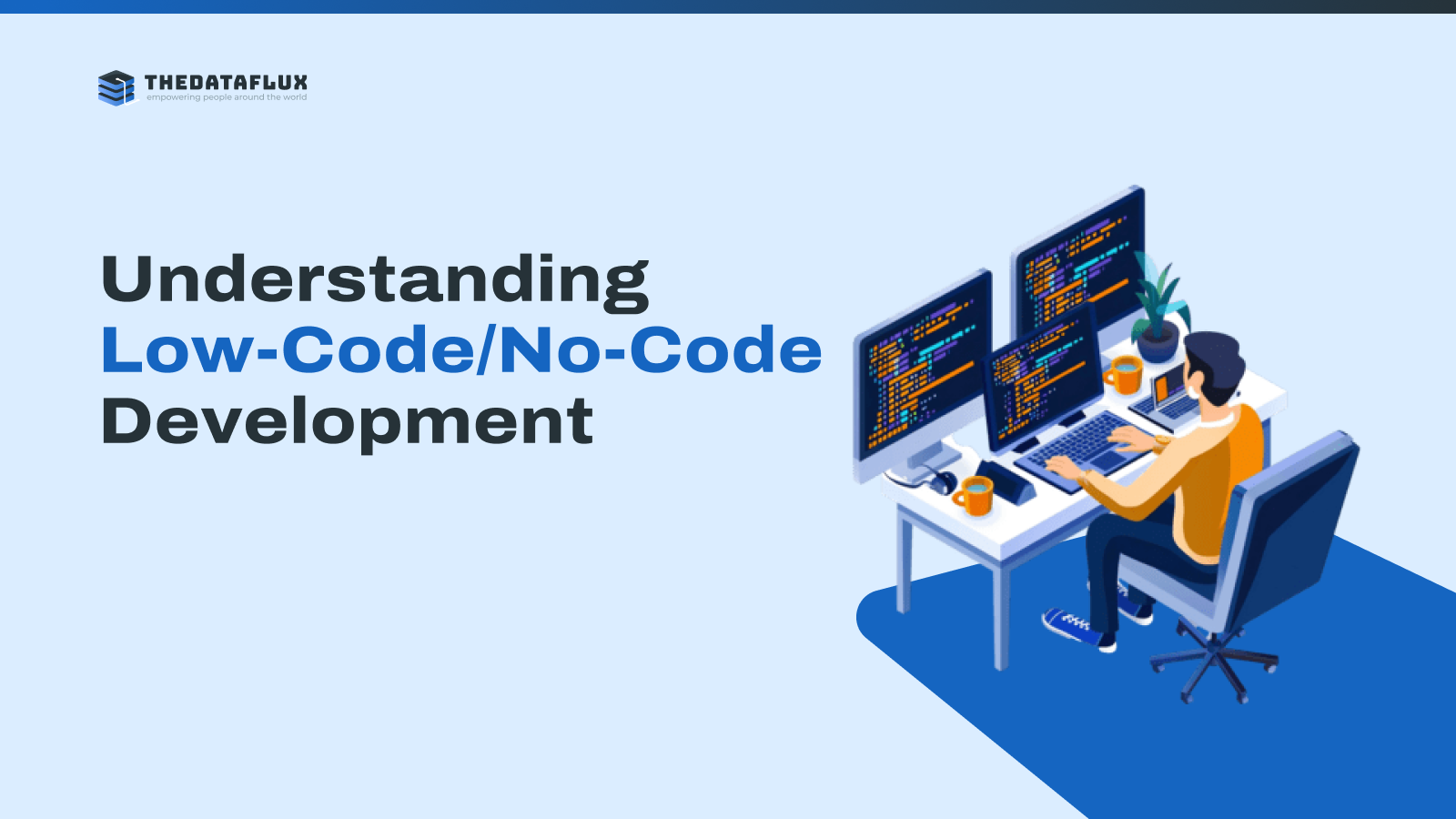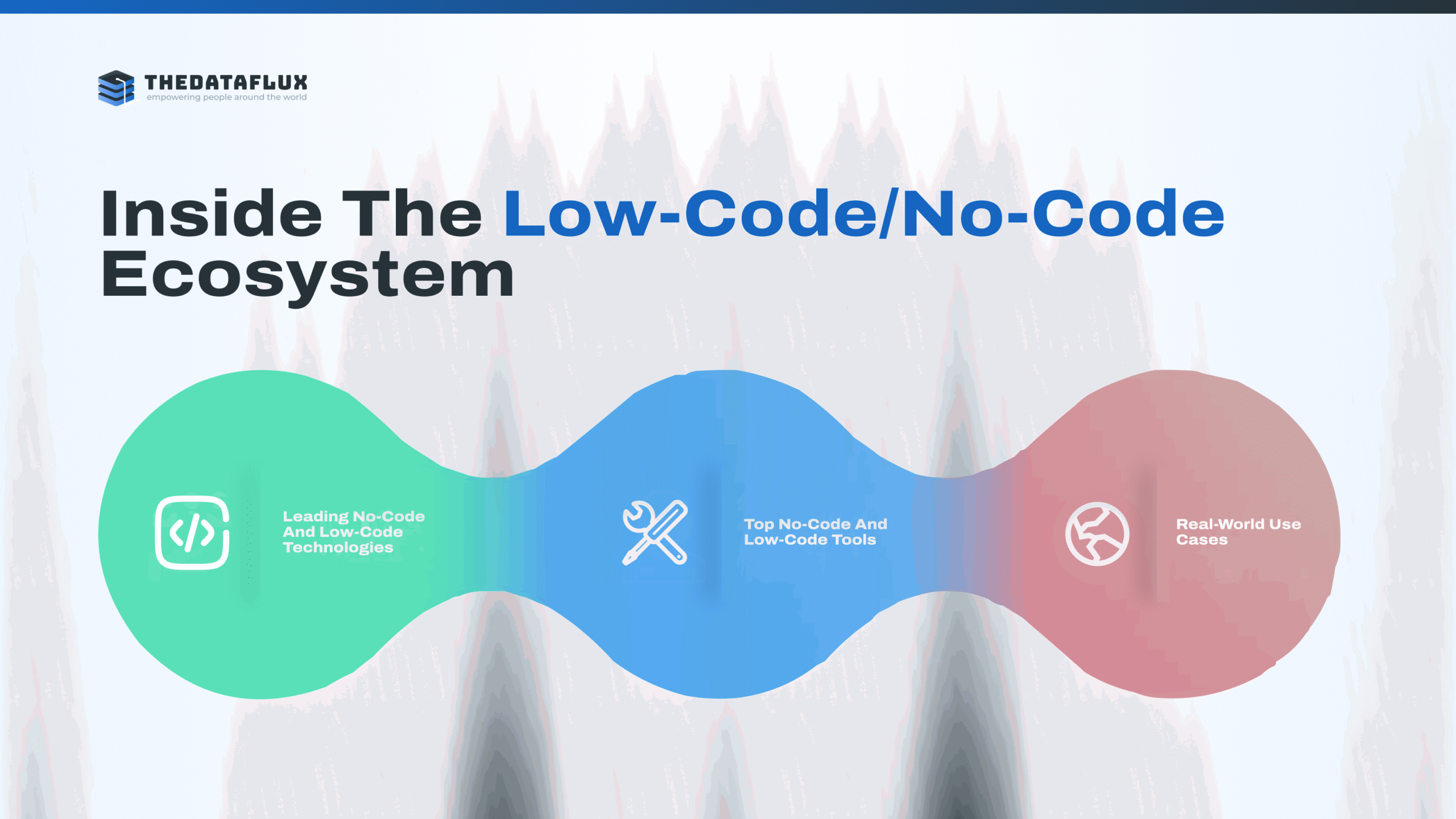Low-Code/No-Code: The Future of App Development

Did you know that nearly 70% of new business apps in 2025 will rely on low-code or no-code tools? That’s not like a wake-up call; it’s a prediction.
Businesses for years thought that software building meant writing thousands of lines and hiring a full developer team. They thought that they had to wait months to launch. But times have changed. Even someone in today’s world with absolutely zero coding experience can automate a process, build a customer portal, or create a working app, all of which is done without writing a single line of code.
That’s the power of low-code and no-code development.
This blog will break down how low-code/no-code (LCNC) development works, what it is about, what platforms exist, and why big and small businesses are adopting it. We’ll simply do it without fluff, so you actually can use this information.
Let’s dive in.
Understanding Low-Code/No-Code Development

What is Low-Code/No-Code Application Development?
Think of low-code/no-code as the shortcut you didn’t know you needed.
It is a modern approach for the building of software applications through visual interfaces, plus drag-and-drop tools, and also pre-built logic. You can therefore build apps much faster, even without a full development team. These platforms take care of the complex backend work while also allowing you to focus on functionality, design, and problem-solving.
Now let’s split them up and look at low-code and no-code individually.
What is Low-Code?
Low-code platforms are like the training wheels for software development.
They are designed both for developers and for users who do want some code control yet do not want to start from scratch every time. It is possible for you to move fast without any loss of flexibility because these platforms offer minimal hand-coding plus visual tools.
Custom code for integrations or logic remains possible to write. Most heavy lifting is already done by UI components, workflows, and database connections.
In short: less code, more speed.
What is No-Code?
No-code, on the other hand, is for non-developers in particular. Digital tools are able to be built by anyone through using these platforms with no need for writing even a single line of code. Marketers, operations folks, and HR teams.
Everything is visual. You drag. You drop. You click. You publish.
Simple apps work well for internal dashboards, form workflows, event registrations, or customer support tools. It can cover a huge range of real-world business needs without waiting on IT, though it’s not for complex systems.
Difference Between Low-Code And No-Code
It’s easy to confuse the two. Here’s the simple breakdown:
Feature | Low-Code | No-Code |
Who uses it? | Developers or tech-savvy users | Non-technical business users |
Coding required? | Some (minimal) | None |
Flexibility | Higher (custom code allowed) | Limited to what platform allows |
Use cases | Complex apps, integrations | Simple apps, internal tools |
Speed | Fast | Very fast |
Bottom line:
• Use no-code when you want speed and simplicity without technical help.
• Use low-code when you want to move fast but still have the option to customize.
Key Benefits of Low-Code/No-Code Development

1. Faster Development
Let’s be honest now, traditional app development develops apps quite slowly. You can go from idea to launch with low-code/no-code platforms in hours or even days instead of months. You skip past the setup with these tools’ ready-to-use components and then start building right away. That means feedback faster, time-to-market shorter, and testing faster.
2. Reduced Costs
It is quite expensive to hire a full team of developers with designers. The testers also add to the expense. With the use of in-house teams and also at times, even low-code/no-code platforms let you can build apps with fewer resources. Expensive revisions are then cut down on, and also, development hours are spent far less. It’s a way that is smarter, also leaner, to get done.
3. Increased Productivity
For business teams, it is good to stop waiting on IT when they can build tools on their own. Things are able to move faster in general. Low-code helps developers automate routine tasks, letting them focus on harder problems. Departments become more productive because of this shift. Less time, more results.
4. Enhanced Agility and Flexibility
Markets change fast. Your apps need to stay updated with that. Low-code/no-code platforms make it very easy for one to tweak all workflows or to update features. These platforms permit strategy shifts without starting anew. Quick adaptation avoids the need for long development cycles. That flexibility can greatly advantage competition.
5. Empowered Users
Not everyone is someone who has great ideas and must write code. No-code tools let teams lacking technical skills create solutions without developer dependence. Because of this empowerment, ownership strengthens, problem-solving accelerates, and innovation increases. The IT team is not the only people who become creators. Everyone becomes a creator.
6. Improved Collaboration
Low-code/no-code platforms cause IT and business teams to be more connected. Everyone can visually see, test, and tweak applications, so alignment is maintained and collaboration is easier. Shorter feedback loops occur as misunderstandings go down. That means fewer back-and-forths as well as improved outcomes.
7. Simplified Integration
Modern businesses rely on dozens of tools; those tools need to talk. Low-code and no-code platforms often come along with built-in connectors. This includes connectors that are for CRMs, ERPs, payment systems, and even more. Upon integration of different platforms, it becomes a matter of a few clicks, not weeks of coding. It simplifies the process and saves valuable time.
8. Scalability
Something built with haste is not necessarily a fragile thing. Fragility does not necessarily correlate to a quick build. Scalable architecture is supported by many low-code platforms, so the app can grow as your business grows. You can begin modestly, then grow features or users without total rebuilding. Both the startups and the enterprises benefit from the LCNC tool.
9. Democratization of Development
Tech is shifting in one of the most exciting ways because software creators are not just developers. Anyone is able to use the low-code and no-code tools. They turn the ideas into working applications. That allows innovation for more people across the organization. Those people can create innovation in abundance. It makes competition fairer.
Inside The Low-Code/No-Code Ecosystem

Leading No-Code and Low-Code Technologies
Low-code and no-code platforms are not just simple visual drag-and-drop tools. Actual technology beneath the hood powers them, making development smarter, faster, and smoother.
Here are some of the common technologies and capabilities that power these platforms:
• Visual Development Interfaces
These are at the heart of the LCNC tools. Pre-built blocks enable visual app design. You also use workflows as well as logic elements, foregoing code writing. It feels like building upon LEGO. That is, it acts instead of coding things.
• Reusable Components
Templates that are reusable, modules that are reusable, and UI components can be used on most platforms. These platforms provide flexibility in design, as well as in development. You can just pick and customize it: you do not have to design or code buttons, forms, or dashboards from scratch.
• Workflow Automation Engines
When a form is after it is submitted, send an email, or when a task is after it is completed, update a database? Automation engines let you establish logic and rules without any scripting.
• API Integrations and Connectors
For popular tools, these platforms often come with built-in connectors. Hundreds of more tools, such as Salesforce, Slack, Stripe, and Google Sheets, are available too. That means different systems can easily connect, also your data can keep flowing smoothly.
• AI and Machine Learning Add-ons
Chatbot builders or smart forms that suggest are AI-powered tools, and some platforms now feature recognizable images, requiring no AI experience. This is because every day, apps gain more intelligence.
These technologies make low-code/no-code platforms powerful, as well as capable of building serious solutions, and easy to use.
Top No-Code and Low-Code Tools
Let’s look at some of the most popular and widely used platforms across industries. Each one has its strengths depending on what you want to build:
Mendix (Low-Code)
Focused on speed and collaboration. Mendix is used for building everything from simple web apps to full enterprise software solutions.
Microsoft Power Apps (Low-Code/No-Code)
Part of the Microsoft ecosystem, it lets businesses build apps that connect directly with Excel, SharePoint, Teams, and other tools they already use.
Zapier (No-Code Automation)
Not for building apps, but perfect for automating tasks between apps. Think of it as the glue that connects your tools together—without coding.
Each of these platforms has its own learning curve and target audience, but they all follow the same idea: build faster, with less code, and fewer barriers.
Real-World Use Cases
• Internal Tools & Workflows: HR, finance, operations, and other departments are building tools such as approval workflows, employee onboarding systems, inventory trackers, and data dashboards because of the fact that they do not want to wait for months for dev teams.
• Customer Portals & Front-End Apps: Platforms like Bubble also Softr are used by Teams to build apps that customers use, such as client portals, booking systems, also support ticket platforms, designed to match their exact needs.
• Automation & Integrations: Zapier helps businesses make repetitive tasks automatic. Automation and Integrations are achieved by Make (formerly Integromat). For example: when a customer submits a form, Asana gets a task as well as a confirmation email is sent. Also, a CRM record gets updated automatically.
• Data Collection & Reporting: Teams use platforms such as Airtable or Glide to collect, manage, and visualize data by building tools more interactive, useful than prior spreadsheets.
• Startup MVPs: Founders can use no-code tools for startup MVPs that quickly validate ideas. They launch MVPs in a matter of days instead of hiring developers, since that is something that saves money and gets real feedback prior to scaling.
The Future of Low-Code/No-Code Development
Low-code and no-code platforms are no longer optional “nice-to-haves”; they’re rapidly turning into vital tools in development now. Toward the future, features get smarter, and integration gets easier, so we are heading toward a future where anyone with an idea can turn it into a working app, faster, cheaper, and without relying fully on developers. With AI included, software becomes something that practically builds itself now.
But while the tools make building easier, the strategy behind what you build, and how you scale it, still matters. Businesses will get stuck at that point because they do not know just what platform to pick, how they can integrate with systems that are already there, or how they might build something scalable.
At The Dataflux, we help bridge that gap. As an IT company for consulting and development, we help businesses use low-code and no-code tools the right way. We combine visual development’s speed with expert-level planning, customization, and integration.
The future of app development is collaborative, visual, and incredibly agile.
The question is- are you ready to build that future?
